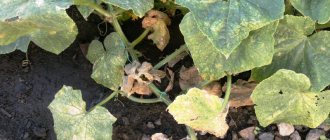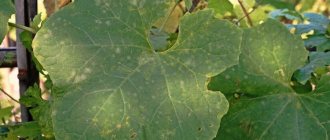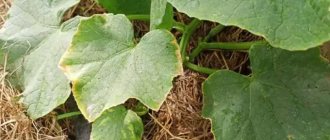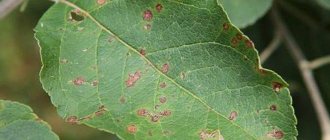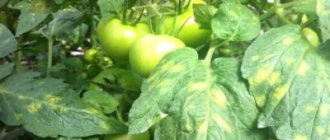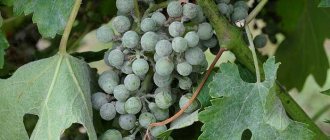Some diseases and damage to potatoes are completely invisible on the skin. It happens that when you cut into a healthy-looking tuber, you discover that inside it is lined with brown, black or red spots and veins. It is almost impossible to completely cut out the marks and it is unknown whether such potatoes can be eaten at all.
From the article you will learn what these veins mean, whether you can eat potatoes with colored stripes and spots, and how to avoid the appearance of brown veins and spots in tubers.
Main signs of non-infectious potato diseases
The main causes of such diseases are
- Wrong proportions of fertilizers.
- Failure to comply with the rules for storing tubers.
- Inaccurate transportation of potatoes.
To avoid the appearance of such spots, you need to reconsider the proportions and schedule for applying fertilizers, try to change the harvesting method, for example, dig potatoes not with a shovel (since you can’t dig without injuring the root crops), but with a pitchfork, transport and handle the potatoes more carefully.
Keeping the tubers in a dark, well-ventilated room before transportation will help to significantly reduce the percentage of tuber diseases. The potato skin will become rougher, and the tubers will be more resistant to physical stress.
Gray spotting of tubers (melanosis)
With melanosis, spots on potatoes can be not only brown, but vary from light gray to dark purple. On a seemingly healthy tuber, when the peel is removed, dark spots with unclear boundaries are revealed. If the darkened part of the potato is not cut off and cooked, it will turn black. Starchy potato varieties are most susceptible to this disease.
As a rule, such spots resemble bruises and appear in places where the tuber is injured. But there are other reasons for the appearance of this disease:
- disproportionate application of fertilizers;
- potatoes dug up ahead of time;
- the soil with already ripened tubers is too hot (hot weather without rain);
- storing the crop at low temperatures in a poorly ventilated area;
- storing tubers in too warm conditions, at temperatures up to 12 degrees Celsius.
Storage Features
Diseases can appear not only during the growth period, but also during the storage period of tubers. The cause of the formation of diseases can be mechanical damage. To prevent potatoes from being exposed to dangerous fungal, bacterial or other diseases, you need to choose storage locations wisely.
- not store potatoes in direct sunlight , as this promotes the release of solanine.
- not store potatoes in the refrigerator . At low temperatures, starch can transform into sugar, and the taste of the fruit will noticeably change.
- not store potatoes next to onions and garlic . Vegetables will spoil instantly. Fourthly, storing potatoes in plastic bags is not allowed, they stimulate the formation of toxins.
Potatoes should be stored in a dry, ventilated and dark place.
It is advisable to store potatoes in fabric or paper bags, wooden or plastic containers, and in specialized pits. The shelf life of ripe potatoes ranges from 60 days to 6 months.
New potatoes cannot be stored for more than two weeks. Under no circumstances should fruits be frozen, and storage in the refrigerator is allowed only for 3-5 days.
Iron spot (rust)
If the tubers look healthy, but when they are cut, reddish-brown spots appear in the form of rings or dots, then the plant has been affected by rust. This disease appears after 1.5-2 months of storage. Its main cause is a lack of phosphorus and an excess of iron. To prevent this from happening, organic fertilizers and watering should be applied in a timely manner and in the optimal amount so that all useful substances and microelements are well absorbed by the plant.
Reviews
Alexander B.
I have been using the drug “Maxim” for more than three years and have no plans to change it. The product is universal, I am very pleased with its effect. I use it when planting potatoes and spray the crop before storing. Very economical. The main advantage is that potatoes after processing are not dangerous to eat.
Maria S.
My favorite remedy is Fitosporin M. This is not just a fungicide, but a bio. Fights well against fungi and late blight. I take the preparation in the form of a paste (I like it this way) and water the soil before planting. The potatoes grow healthy and large. I've never had a black leg before.
Fungal infections of potatoes
To prevent fungal infections from affecting potatoes, you should adhere to the rules of crop rotation in your garden plot and do not plant nightshade crops next to potatoes.
Seed potatoes must be stored separately from “food” potatoes. And when spring comes, green up the seed tubers, leaving them in the light for 1-2 weeks. Before planting, treat the seeds with Bordeaux mixture, copper sulfate solution or ready-made fungicides, which can be purchased in specialized stores.
If, nevertheless, the plants are affected by a fungal infection, and characteristic spots appear on the tubers and leaves, the tops should be mowed and burned two weeks before digging. Tubers from affected bushes should not be left for seed. Rotten tubers affected by late blight, Alternaria or Phoma must be collected and burned.
Why do potatoes turn black when cooked?
Potatoes may turn black during heat treatment, boiling or frying. The root crop becomes covered with dark spots or stripes.
It doesn’t look very attractive in a salad and spoils the appearance. Browned potatoes are unpleasant to eat. The blackness is not caused by putrefactive bacteria. It is due to other factors.
Potatoes turn black inside due to improper storage conditions. After harvesting, the root crops are treated with an antiseptic, dried, and placed in a dark, damp room. The optimal temperature is 4-7 C, air humidity is at least 70%.
Specialists of the Institute named after. A.G. Loch conducted a lot of experiments. They took potatoes from storage, where an optimal microclimate was maintained. It darkened when cooked and fried. The chips did not turn golden brown. They turned black. Scientists began to experiment with the temperature in the storage facility.
They came to the conclusion that it is better to store root vegetables at a temperature of 10 C. In this case, the pulp does not change its color during heat treatment.
Exposure to low temperature. Potatoes of mid-season and late varieties are recommended to be harvested before frost. At temperatures below zero, starch breaks down into glucose.
It changes the taste of potatoes, the pulp becomes sweet, which the consumer does not always like. At the same time, it gives a dark color to the potatoes. The more starch there is in root vegetables, the more glucose they produce.
Lack of minerals. During the growing season, potatoes require a lot of potassium, phosphorus, nitrogen, magnesium, manganese, boron and other elements. Otherwise, plants develop with pathologies. This is reflected in the tops and tubers.
To prevent the potato pulp from changing color, it is recommended to soak it in water for some time, up to 30-60 minutes. During this time, some of the starch and mineral salts leave the pulp into the water. During heat treatment, it does not darken, but the potatoes will become less boiled. To avoid black spots on potatoes, you must follow the rules of agricultural technology when growing them, harvest before frost, and maintain a temperature of 10 C in storage.
The leaves and stems become weak, change from green to yellow, reddish, and the crown may rot. Stolons develop poorly, tubers are deformed and grow poorly.
More on the topic: What early potato varieties are there?
To support potatoes during the growing season, gardeners introduce fertilizers with ammonium nitrate, urea, potassium salt, superphosphate and other mineral fertilizers.
The lack of chemical elements may not be immediately noticeable, but it becomes apparent during storage. Black spots on the pulp are a consequence of improper care of potatoes.
A similar phenomenon occurs when there is an excess of minerals. Experts urge the use of fertilizers for root crops according to a certain scheme, according to the instructions for fertilizers.
View this post on Instagram
Publication from Wholesaler1First
